
by wemakedo | Sep 20, 2019 | health, Plastic Free July, transport |
To whom it may concern at Aer Lingus,
I recently used your new transatlantic service from Dublin to Seattle and I found the service to be very good, in keeping with what I have come to expect from AerLingus as Ireland’s national carrier and a 4-star airline.
However, I am writing to highlight one aspect of your service that I was very disappointed with.
That is the amount of consumer plastic waste being generated on each crossing on this route.
Here is will highlight some specific areas that I noted on the flight which could be easily addressed and then I will finish by proposing that AerLingus has an opportunity to take a leading stance in improving on the waste generated from its inflight service when other airlines seem to be ignoring this very “front of house” and sadly very wasteful aspect of the service.
Firstly the travel blanket supplied to each customer is wrapped in a plastic bag only to be immediately removed and trashed without a second thought. I took a mini poll of other travellers to ask their opinion of the use of this wrapping. All (only 4 travellers) felt that this attempt to make one feel that blanket is “fresh” and “clean” is unnecessary when considering the resulting 300 bags being dumped from each flight. Perhaps there would be a less impactful way to convey to passengers that these blankets are fresh when received? Even a paper bag if a bag was really thought to be necessary?
Next each cup of hot beverage used was given in a disposable plasticised cardboard mug along with a plastic lid. I recall on flights taken in previous years where the drink could be poured into the cup received on the food tray and no plastic lid was required. Here I am considering the 300 (or perhaps multiples of 300) lids and cups being dumped from each flight. Perhaps even encouraging passengers to reuse these cups if they intend to have a second cup of tea/coffee might at least give a positive message and make passengers at least aware of the cumulative waste being generated. Perhaps a bring your own mug program could even be somehow incentivised (I know that we did on our flight and I noticed others doing this)
Next, the headphones provided to each passenger came in a disposable ziplock plastic wrap. This was immediately opened and 300 wrappers dropped/stuffed into pockets on the plane. Is this wrapping really helping anyone? On other airlines, I have noted that the unwrapped headphones were handed out after takeoff or simply left unwrapped on the seat, thereby avoiding yet another source of near-useless but highly damaging plastic wrapping.
Of course, then there was the food tray – a sea of single-use plastic. This is a more difficult one to address given the obvious constraints that airlines face in having to provide this service without adding to the service overhead for the flights. I do feel however that instead of following what other airlines have always done, there is room for AerLingus to lead the way in trying to slowly address the amount of disposable plastic arriving in each meal serving.
I did note on my flight that the second snack offered, was provided in a cardboard container without any plastic. Whether an intentional effort was made to reduce plastic in selecting this or not, I for one appreciated it.
I feel that more choices like this could form part of a concerted campaign on your part to address the amount of waste generated during flight and could be highlighted as part of a broader effort on behalf of Ireland’s “green” airline to make industry-leading efforts to be “green” in all aspects and to change the way inflight service is provided. The public relations benefit could be appreciable if AerLingus were to have an environmental impact statement with a declared intent to try to address inflight waste as well as perhaps the other impacts from the business process. I looked for but could not find any such statement online – nor could I find one for your nearest competitors either.
In fact I noted that a competitor of yours (Ryanair) was recently highlighted as one of the worst carbon polluters in Europe (not just of airlines but of all businesses). The air pollution aspect of flying is clearly a very difficult issue to tackle but I am urging you to tackle the easier and more obvious side of the inflight experience and thereby send a strong message to consumers.
You likely don’t need to hear yet another person reminding you of the effects of air travel on the environment, and as a user, I hold my hand up and will admit that I am a somewhat frequent user. But like many of us who feel we need to fly, I do think that there is a lot of scope to clean up the secondary waste stream being generated on these flights for no real gain to the consumer and perhaps at a cost to the airline (for example, time spent cleaning it up and disposal costs as well as no PR benefit).
AerLingus prides itself on its customer service and I note you are recognised for providing a 4-star service. Therefore I can understand someone making the decisions to use wrapping to add to a quality feeling that you think passengers are seeking. But I really feel this is misguided in its intent as many travellers these days are quite concerned about the overall impact of this form of transport and these methods have the very bad effect of delivering lots of additional plastic waste into our overburdened world.
I respectfully ask that you don’t ignore this request from a concerned customer and that even if you decide not to directly address these concerns (not just mine I assure you), that this concept could be taken on board and incorporated into your longer-term planning as to how you want to improve your future service. Perhaps AerLingus could take a lead that others might choose to follow.
I look forward to hearing more about what AerLingus can do to help alleviate the damage from this service in some small regard.
Yours sincerely
etc…
submitted to Aer Lingus customer care on September 19th.
By the way, the image at the top is from a report about a small Portuguese airline that took the action to make their service plastic-free this year. Seems like it can be done. If this really seems trivial compared to the impact of flying itself, then think of the simple message if gives to so many people who choose to fly – i.e. the potential effect it could have on passengers thinking by simply making this statement so clearly.
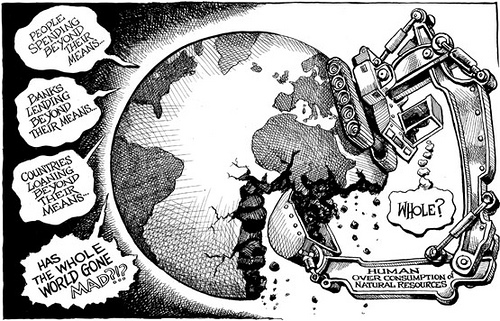
by wemakedo | Nov 9, 2018 | community, health |
By now I think most of us have at least seen headlines related to the recent IPCC update on climate change which describes the impacts of further global warming. To add to this, more recently, the World Wildlife Federation (not to be confused with the wrestlers) released their latest 2 yearly report on the state of our wildlife. Both of these reports are truly shocking in the facts that they present. And it should be noted that although there is some opinion included, these reports are summaries of the best factual data we have on our current situation. If people need more evidence of the sorry state of our global environmental health, it’s all here.
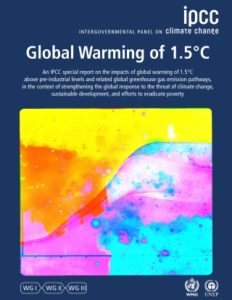 And let’s be honest with ourselves – in both reports the current situation and the prognoses are both presented as dire situations.
And let’s be honest with ourselves – in both reports the current situation and the prognoses are both presented as dire situations.
And these are not the kind of “dire” situations where for example, jobs are lost or economies are down turning or prices are rising or a storm is coming or some of the other crisis events that preoccupy our media all the time. This is on a whole other level, like the destruction of the planet level. I don’t know whether humanity has ever before knowingly faced such a huge imminent problem and responded with such an apparent lack of urgency.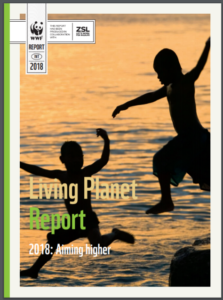
Is this sinking in at all?
For those who are perhaps climate change sceptics or merely indifferent to it all, and feel that consequences that are still years away are not to be taken too seriously, then the WWF report makes our situation clear and the cause of this situation even clearer. The report directly blames our consumption habits: “Runaway consumption has decimated global wildlife, triggered a mass extinction and exhausted the Earths capacity to accommodate our expanding appetites”
As the head of the WWF declares ominously in the report, “we are the first generation to know we are destroying our planet and the last one that can do anything about it”.
Why are we not all talking about this with the urgency it deserves ???
Why is our media not saturated with more discussion on this?
For some perhaps these are just yet more of the same kind of reports that preach doom and gloom, and that we need to do our best to not get dragged down by. But for those who are listening to the message contained here, there is a lot to be very worried about now and alot that we should be taking far more drastic action on.
We are clearly in a crisis situation that we are either paralyzed to act on or simply too self-absorbed to even notice despite the very clear warnings we are now getting.
It seems like most of us are hearing this message and choosing to believe that life will just go on as normal, the way it always has. Perhaps we are tending to make a subconscious decision that we can’t affect this with our individual habits anyway or that if it really was such a big deal wouldn’t our government be taking more radical action on this on our behalf?
This thinking is starting to look very foolish and delusional.
Mrs Wemakedo has recently gone back to school for some new learning on environmental engineering and so she has been reading a lot of the latest thinking on the state of the environment and latest efforts to mitigate our destructive impacts. So we have been discussing some of these concepts at home a little more and let’s just say that a quiet air of foreboding has begun to set in for us.
On some level, it’s consoling at least to see the huge amount of investigation, analysis and planning that is taking place in various fields of industrial and commercial activity to try to get a handle on the environmental side effects of our economic activity. But this seems minuscule in comparison to the huge momentum already built up by the destructive methods we have engaged in unchecked for so long now.
The latest IPCC report is attempting to put in clear terms what needs to happen to avoid near certain disaster for much of the world’s population. It lists climate-related risks to health, livelihoods, food security, water supply, human security and economic growth. That pretty much covers a lot of what we consider important in life, so maybe we should listen harder this time? Avoiding these catastrophic scenarios will require far-reaching and unprecedented changes in society!!
The WWF report is equally stark. Since 1970, we have now wiped out an estimated 60% of all creatures with a backbone (vertebrates) due to our unrelenting destruction and pollution of the environment.
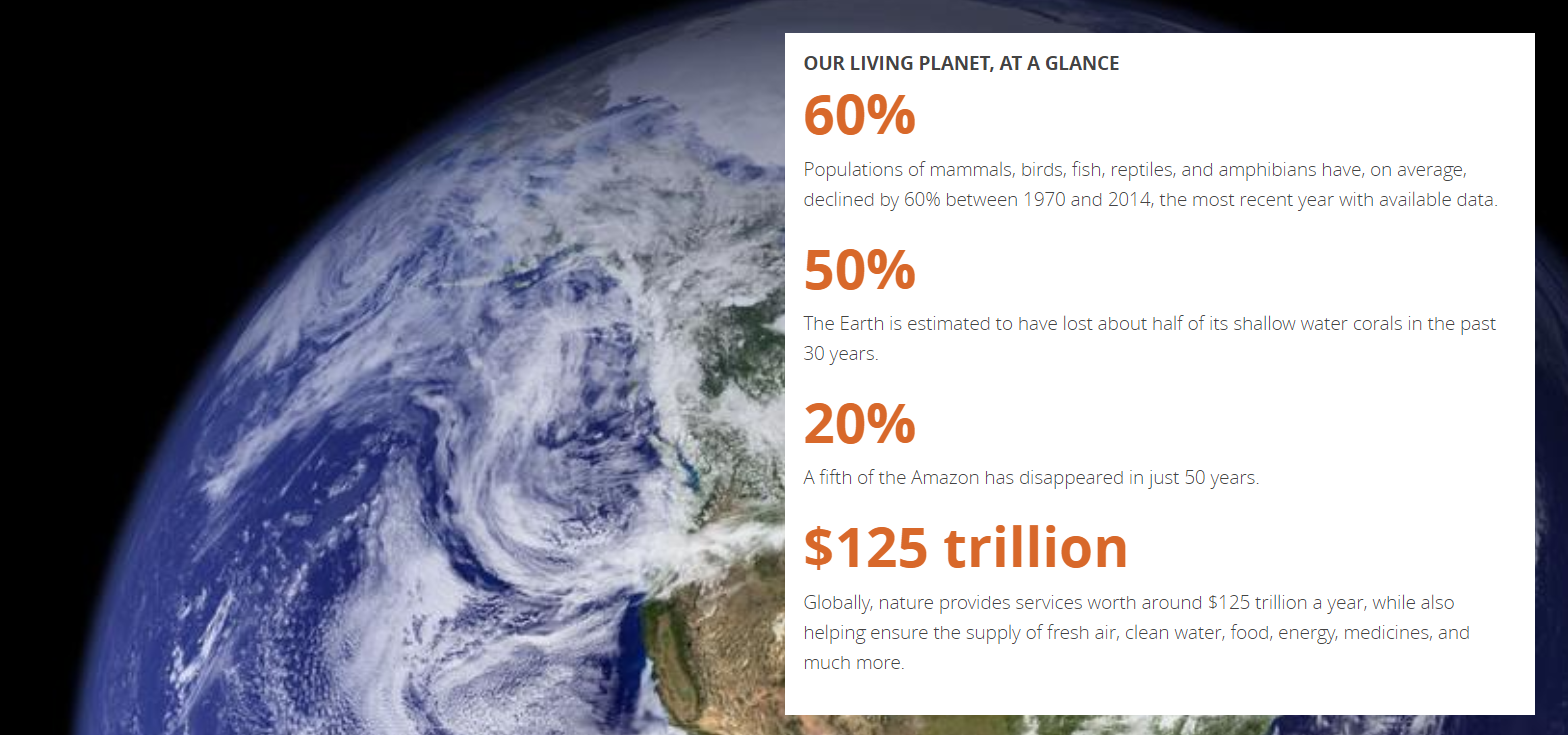 A little background on the IPCC report: this report was commissioned in 2015 after the Paris Climate Accord when it was not really clear what would happen if the world were to limit the global temp increase to 1.5C above pre-industrial temperatures (before 1900) versus limiting it to 2C. This report was requested to go figure out the real world scenarios in both cases.
A little background on the IPCC report: this report was commissioned in 2015 after the Paris Climate Accord when it was not really clear what would happen if the world were to limit the global temp increase to 1.5C above pre-industrial temperatures (before 1900) versus limiting it to 2C. This report was requested to go figure out the real world scenarios in both cases.
It doesn’t sound like much but keep in mind we are now (2017 data) believed to be at about 1C higher (within 0.8 to 1.2C (– high confidence)) already and accelerating! Some climate scientists are adamant that we are even higher if a less conservative analysis is applied to the available temperature data.
The CO2 level is not static or even slowly rising – this is actually ACCELERATING according to the latest data collected.
The report makes it clear that if we stopped emitting CO2 now, that is, immediately went to a zero Carbon society across the globe, that the impacts of what we have done will persist for decades and likely millennia in the form of environmental damage. If you pause and think about this it’s very worrying in itself…but then consider how well we are doing at slowing this down for the future.
It’s simply not happening.
As one researcher said “we are sleepwalking to a disaster with climate change”. And here is where the really concerning findings occur.
If we were to limit the damage to the scenario of a 1.5C increase then we would have to be at zero Carbon output by 2050!. That’s dropping from the highest CO2 output levels we have ever experienced to zero in just over 30 years!
The report estimates that we will reach 1.5C above pre-industrial levels (from the current 1C) by somewhere between 2030 and 2052.
So in the next 12+ years, we will see the far more serious consequences of this unchecked behaviour.
Let’s take an example from the report to get some idea of what this could mean. At the 1.5C mark, it is estimated that we lose 70 to 90% of the worlds coral reefs…that’s 90%!.
At 2C, this goes to 99%. No more coral reefs.
For many of us, it’s hard to identify with this as we likely won’t suffer much directly from having no more coral reefs – those pretty features favoured by underwater documentary makers. But to say that we might just be about to permanently kill them all off without much of a second thought is distressing. For those with children, imagine how you would explain this to your kids….”yeah, we knew it was happening but didn’t seem bothered enough or organized enough about it at the time to do enough to stop it”.
The report even mentions the use of extreme “geoengineering” as one possible solution to be considered given the dire situation we face. A quick internet search reveals that this is not a new concept to try to tackle the problem but is one that is now being mentioned more frequently as those in the know realise that this intractable problem looks to be one that is just that – intractable. We really just can’t seem to help ourselves.
One of the geoengineering ideas floated is to fill the clouds with Sulphur to mimic what happens after major volcanic eruptions when sulphur dioxide is ejected into the atmosphere and converts to sulphuric acid which is then able to reflect back lots of sunlight leading to a large temperature drop. It has worked during previous large-scale eruptions so could possibly be made to work artificially. However as these articles point out, if this could be done and if it was to work, this would only buy some time to fix the underlying CO2 generation problem but if you stop doing this engineering without having changed the background CO2 problem then the sudden temp change would have “disastrous effects” on our climate. It’s a last resort option to avoid the 2C temperature rise scenario, and one that needs a lot more figuring out, but maybe we need to start thinking in terms of last resorts now.
ref : https://earther.gizmodo.com/the-machines-that-could-darken-the-sun-to-stop-climate-1825452265
The world is full of legacy systems and methods that have been handed down to us as “the way things are done”. Knowing the way to do things from our predecessors allows us to go further and make progress in different areas without having to spend time relearning the basics. It’s how we progress
But then we also know the benefits of being able to disrupt the status quo with innovative thinking – take for example the prestige associated with an entrepreneur realizing that they can achieve some economic output in a far better way than before. These people are our modern day heroes.
Shouldn’t this disruptive spirit be channelled more urgently towards this crisis situation we face?
We have adopted some truly terrible ways of doing things that we seem to be unable to even acknowledge, much less be bothered trying to disruptively change them. Unfortunately, there are many agents who are incentivized to ensure that you don’t think too hard about some of these behaviours and question the methods that have been handed to you as, simply, “the way things are done”.
Think about the way cigarettes were sold to the public and how long it took before the medical evidence was able to break through the momentum this industry had built up on the back of high profits.
Think about the way cars are sold to us as, electronics and so much of the other crap we digest at increasing rates.
Think about the consumption of non-essentials in general. The only model we know seems to be to sell more stuff to more people to make more money. Where is this approach leading us? These reports are laying that destination our clearly for us now in ever more dramatic terms.
We should not be so naïve as to think that the way we are shown to behave by those with strong incentives, is in any way aligned with our best interests. And it would seem that we don’t yet see how closely our own best interests and the environment’s best interests are intertwined. If we were being trashed by hurricane storms with increasing frequency in Ireland would we start to wonder more about why this was happening? Woud we thne feel the need to take more personal action on our daily habits?
Where has our critical thinking gone in order to be able to see what is going on around us at a time when it’s not possible to hide all this evidence any more
Recently we watched a BBC documentary about the damage being done by the fashion industry. It was shocking for two reasons. The first reason was that it has extremely high levels of chemical pollution associated with its processes which seem to be going unchecked and at the same time that industry has managed to trick us into wanting new clothes at much faster rates than before…
so what you may say? many industries have managed to quietly pull this trick on society with their own particular play on our needs and insecurities.
But what was really shocking is how well the fashion industry seems to have managed to keep this one out of the limelight. At least for us as we watched it, we were shocked to realise how bad that industry really is while maintaining a relatively clean image. Remember when we became aware that some clothing companies were using child labour to make clothes, and how quickly public pressure came to bear to try to stop that practice?
Well, all the while the clothing production companies have been quietly trashing their local environments while helping eager high street buyers stay “up to date”. This documentary is worth a watch if you need some more shocking evidence of why a seemingly benign industry is, in reality, doing horrendous damage… second only to transport in the level damage that it does (link)
Taking time to look around, the environment seems like just one of the many problems we face. But as these two reports are clearly telling us, we need to stop ignoring or underestimating the severe consequences of what we are doing to the planet. If there is a solution to this it lies in our individual habits….no self-interested government is going to fix this. On a local level, people may have forgotten that improvements that get made by governments only come about in response to public demand. The urgent change needed will only happen through people taking their own actions to change.
We must realise that the effects of the environmental damage we are doing are no longer far removed from us in the first world. We are in a crisis that now needs an individual response. As both these reports make clear, we are at the point where we may be the last generation that can possibly do enough to reverse this.
We’ve heard the message again and again. How much more convincing do we need?
We shouldn’t need to be forced to act in the best interests of our future.

by wemakedo | Feb 27, 2018 | money, transport |
We had been nursing a very old car along for 15 years until it recently expired with a whimper. My most recent “fix” was to drill holes in the floor to let out the water that it had been accumulating, so its days of useful service were numbered.
To be honest the car was already 8 years old when we bought it making it one of the oldest things I’ve seen on the road at 23 years of age when it finally had enough. They just don’t make them like they used to..this thing had never had its clutch changed or touched in any way and after 23 years of service, the clutch finally wore out.
Our 1995 Micra was dead – or at least a clutch replacement didn’t seem worth the cost to us.
Moving on, we figured we would at least give some thought as to how we might manage on a single car. But with three young school going kids and living in the country this proved to be very difficult. In the end, it was simply too difficult for us to manage all the demands and we decided that our best option was to limit the harm we would do with our next vehicle over its life – the obvious answer here is an electric car (or EV – Electric Vehicle).
We looked for and found a 2013 electric Nissan Leaf and decided that was the way to go.
For a second car we didn’t want to splash out, firmly believing that cars are about function rather than looks. More of an unfortunately necessary waste of money and a highly depreciating asset as well, than a pleasurable investment.
Browsing the relevant websites brought back those familiar feelings of how much the car dealers profit from used car sales and how private sales offer good value if you can evaluate the car to your satisfaction.
The interesting thing about purchasing a used EV from a private seller is that relative to combustion engine cars, these cars have very little that can go wrong. The state of the battery is the obvious main concern, but really they are a considerably lower risk purchase to make than a standard car with so much unseen mechanics that can go wrong. How would you ever know if a clutch was about to go? Does it burn oil? Are the engine gaskets in good shape? Did the timing belt really get changed?
Not on an EV – it doesn’t have such hidden liabilities.
The EV will display its travel range to you and although apparently, it may be possible to tamper with this, there is a nice cheap app that you can use, along with an OBDII code reader to query the car and see the true battery lifetime (in AmpHrs) remaining. So you can know exactly what you are buying, and decide if you can live with that range.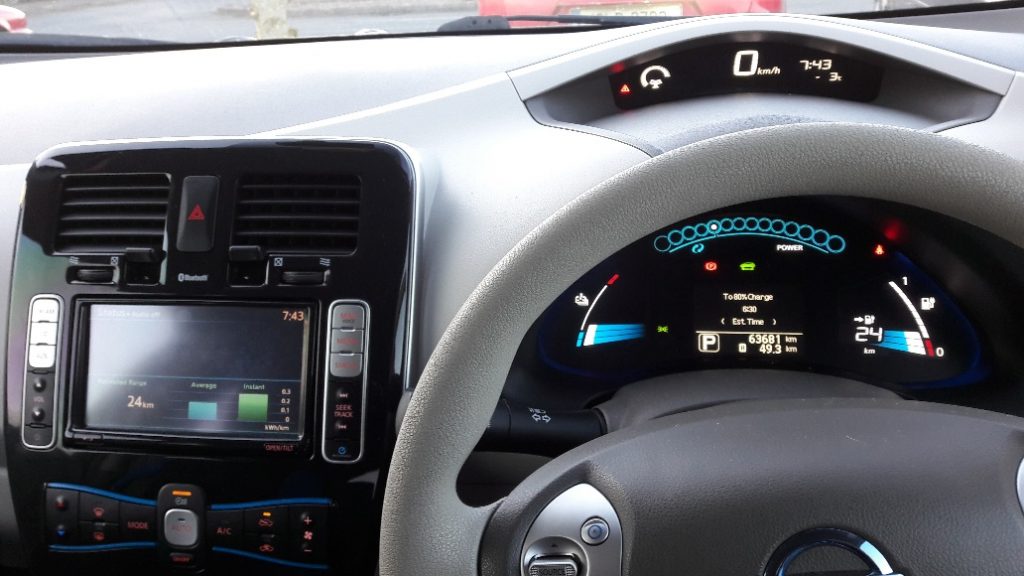
In truth, there seems to be excellent value to be had now in second hand EVs due to the fear associated with used batteries.
Yes, the batteries, of course, will degrade over time and usage and the range consequently drops off. But if you need more than 90 or 100kms daily range then one of these is not for you anyway. But with national daily average mileage at about 27 to 30 miles, then these used EVs can suit many people’s driving habits. But thankfully for us, the uncertainty in buyers minds and the aversion to having to manage your range closely means that second-hand EV prices represent great value.
So we bought it – €7300 euros for a 131 car with 60k km on the clock and 11 of 12 bars range showing.
This particular model had some of the improvements that Nissan made on the original 2011 Leaf design, but still some of the drawbacks. It had the lower capacity 24Kwh battery pack and it also still had a resistive heater which consumes significant power from the battery during cold weather, unlike the newer models which use a heat pump. Considering this and the fact that it had 11 of 12 bars battery capacity remaining we were delighted to spend that to get a nearly new car.
My introduction to driving an electric car, however, was not pleasant.
I bought the car in North County Dublin and planned my drive back to Cork. A few things I learned the hard way:
Dublin has many fast charge points which include the charging cable. When you buy a car that only has a “granny cable” – that is one that plugs into a regular household socket for slow charging – then you are S.O.L. when you pull into one of the many charge pints that require you to have the custom cable/connector. Picture my smile fading as I found my first charge point well outside Dublin with 15 km range left only to realise it didn’t have any connector. Nor did I.
After the new understanding of how this worked settled in and the panic subsided, I realised I had enough in “the tank” to barely make it to the next charge point which did include a connector. I began to realise that my charge point options were now very limited without a cable.
To be fair the infrastructure in Ireland is good, and once you understand the different types of charge points and carry the right cable, getting around over long distances is easy although time-consuming when you factor in the charging time.
On that trip, however, I also learned that a very cold and windy day will significantly impact your range due to wind resistance and if you decide to run the heater to warm yourself. I watched in horror after charging up to the max as the kilometre range value predicted by the car started dropping as I drove along, dropping a lot faster than the kilometres I was covering on the ground.
And so at the height of my misery on that cold Friday night in February, as I huddled in the freezing car at 11:30 pm in a deserted garage forecourt waiting for the nice Nissan breakdown recovery people to find me, with only 10km range left but no charger-point within range – these simple points were becoming well understood:
• Don’t drive so fast on the motorway!
An EV is best driven conservatively on the open road, that is to say, 95 to 100km/hr will deplete your battery a lot faster than 85km/hr.
• Turn off the heater until you really need it!
• Use “economy mode” driving for longer journeys to maximise your range
• Pay attention to the charge point information and which kind of charger you are aiming to stop at, they are not all the same.
I’m sure this information is pathetically obvious to experienced EV drivers as it is to us now having learnt the hard way. But when you are caught up in the buying frenzy, don’t forget to realise that driving an EV is a very different experience to the heedless driving we are all accustomed to in gas guzzling cars with fuel stations everywhere.
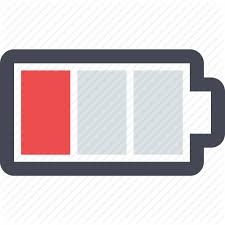 You may have heard the EV related phrase known as – “range anxiety” which newbies experience as they learn to manage their electric car’s needs. It’s real!
You may have heard the EV related phrase known as – “range anxiety” which newbies experience as they learn to manage their electric car’s needs. It’s real!
But it’s treatable with some experience and practice.
I was traumatised by my first long journey experience in a car that should not have been used to cross half the country on a freezing, windy Friday night with no suitable charge cable and a steep learning curve ahead for its new owner.
But now that we understand the range limits and use the car accordingly, we love our electric car and highly recommend them. It recently made the trip to Dingle, covering 135kms with a top up in the middle.
Making that journey was like getting back up on that bike that gave you your first bad fall. That trip repaired the trust and now we’re on the best of terms with our trusty EV. Second hand, the Nissan Leaf is a good value option for households that prefer to own a second car. We highly recommend you consider one if you are in the market for a new car.
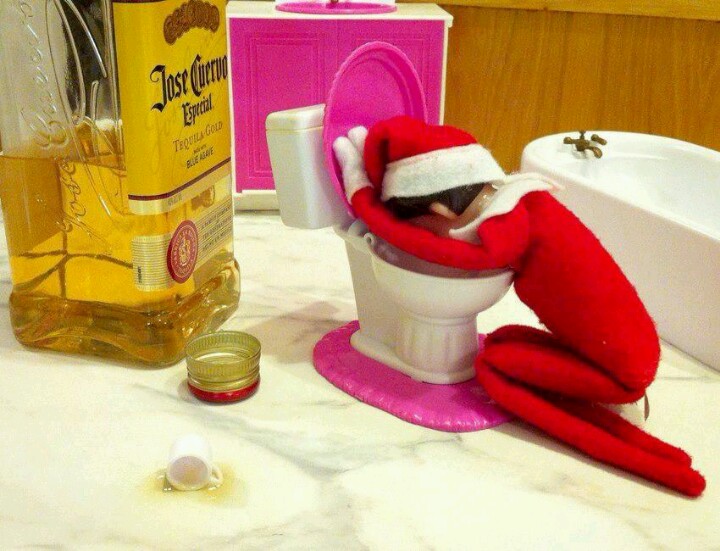
by wemakedo | Feb 6, 2018 | family, money, reuse |
The way Christmas unfolds in Ireland seems to bring conflicting emotions with it. We, like most parents, like to bring some “magic” to the occasion for our children, but it’s a real struggle to do this without feeling like one is on a slippery slope of wanton waste and mindless consumerism. Having been out of the country for several previous Christmas periods, this year we were exploring how we wanted Christmas to feel in our home. It started well with some intentions to engage the kids in some acts of giving each week in the run-up. We didn’t want them to start believing the whole thing is just about the gifts and “what’s Santa bringing you?”.
The amount of times well-wishers will ask kids this question during December is staggering and somewhat irritating. How could children who hear this refrain repeatedly, think about anything else other than their list of stuff and what they are entitled to?? We seem to be hell-bent on spending a month every year teaching them to want things!! Toy companies must be so proud of how well we’ve all bought into this!
Anyway, in the end, we got suckered in; we absorbed the “Late-Late Toy show”, visited more than one “winter wonderland experience”, bought the “Elf on the Shelf” and had our vague good intentions swept aside, and we pretty much signed up for the whole consumerist shebang. Plastic battery operated toys were purchased in spades based on the aforementioned critical Santa “list” and our Christmas morning turned into a whole lot of stuff strewn about the house with the kids obviously confused by the quantity and what to do next with it all. It doesn’t take long before this is the norm and expectations are set for future Christmas’s to come.
 We did at least try to use fabric to wrap the stuff under the tree which worked well, but there was no doubt that the whole event was too much about the purchases despite some vague earlier intentions to inject some other values into the occasion and try to give it a broader meaning. The whole idea of teaching kids to be good so that they can get more stuff from Santa on Christmas day seems like such an outdated lesson to giving our children. What natural conclusions would young minds draw from this as they see it played out year after year at Christmas time? It’s a very self-interested and greed-inducing message to give. Isn’t it time we moved on from this?
We did at least try to use fabric to wrap the stuff under the tree which worked well, but there was no doubt that the whole event was too much about the purchases despite some vague earlier intentions to inject some other values into the occasion and try to give it a broader meaning. The whole idea of teaching kids to be good so that they can get more stuff from Santa on Christmas day seems like such an outdated lesson to giving our children. What natural conclusions would young minds draw from this as they see it played out year after year at Christmas time? It’s a very self-interested and greed-inducing message to give. Isn’t it time we moved on from this?
Something that struck us as we look back on Christmas 2017 is that if you want to do something a little different with the occasion, then you really have to know what you want to get from it and be proactive in your efforts to go after it. Somewhat unclear intentions of trying different things may get overwhelmed in the surge of messages that bombard us all. In a small country like Ireland, “the way things are done” can be a powerful current to swim against.
The Community Reuse Network of Ireland is running a campaign in January which encourages us to re-gift and pass on the unnecessary stuff we have accumulated. Hoarding stuff that we don’t need or use is a sure way to clutter your life. It’s wasteful too, at a time when the world is producing too much. This campaign is encouraging people to “Think a bit differently about January and see it as a month of giving back and decluttering – giving unwanted presents to charity shops, sharing decluttered items on Free trade sites and recycling any unwanted holiday waste and electrical goods”.
Note that the Babymarket.ie is continuing to offer a great way to sell your used child-related items and to help new parents to save some money.

 We also spent the month of December (and November, and October…) glued to the price of Bitcoin. It’s a digital currency or “cryptocoin” that has been in operation since 2010 and has recently become more widely known.
We also spent the month of December (and November, and October…) glued to the price of Bitcoin. It’s a digital currency or “cryptocoin” that has been in operation since 2010 and has recently become more widely known.
You may have seen the news stories late last year as this niche technology captured much wider interest and began to be covered extensively in the media due to its massive gains in value (see the plot shown indicating the exponential rise in value that took place as compared to other asset bubbles).
Having followed it for a few years we decided to buy a very small amount of Bitcoin in September 2017 and were fortunate to experience some of the recent massive surge in value it experienced last year. Huge levels of new interest in this digital currency with only 16 million units in circulation, led to a price increase from approximately $3500 per coin in September to nearly $19,000 in December. It has since crashed back down to $8,000 though and still dropping. But such are the dizzying highs and lows of crypto-coin speculation.
It is interesting to watch the varied commentary when something like this happens. On the one hand, there are those who have bought into this vision of the future and see Bitcoin (and other cryptos) as a future “currency of the people” and say it will soon be worth hundreds of thousands of dollars per coin. A universal currency that is not controlled or manipulated by banks or governments has a certain appeal for lots of reasons.
On the other hand, there are those who represent the established banking industry or government regulators who are making dire predictions of a total collapse of this absurd speculative bubble based on a meaningless creation.
The truth about Bitcoin and other digital currencies is probably likely to be somewhere in between these two extreme predictions. There is enough interest in the technology that there seems to be no doubt it will survive in some form.
As with all disruptive technologies, there are incumbents who are unsettled by its potential and have much to lose when their own industry is threatened…i.e. bankers and government regulators. While those first movers who believe in the technology will vastly exaggerate its potential in order to drive others to get on board.
The argument that Bitcoin is in reality worthless seems strange as, so are all currencies (pieces of paper after all) except that governments back them and give them value. Hence you know your paper Euro has value, but we also know what happens when governments collapse and currencies devalue extraordinarily as is currently happening in Venezuela. This does happen and suddenly a currency can become near worthless when the trust breaks down.
As something like Bitcoin gains acceptance then it will of necessity gain intrinsic value from those who believe in it and are willing to transact it and assign value. The problem, for now, is, of course, its volatility. It’s getting harder for people to sign up to use it when its price is moving by so much and so quickly.
The counter-argument made in favour of Bitcoin is that while unlikely to replace regular currency, it represents a new way to store value in the place of gold. Not that many of us tend to buy gold these days to store value, but you get the idea. If Bitcoin can be readily purchased by anyone with a pc and stored safely (this may be an issue) and it keeps or grows in value over time, then it represents an improvement over gold.
The obvious comparison to make here is to the buying of company stock. When you buy stock in a company, you are investing in the future growth potential of that company. So when your investment goes up, is it because some tangible economic value has been delivered by the people in that company and so you are sharing in the increased company worth as your stock goes up. This doesn’t really apply to the crypto asset class, however, as there is currently no obvious intrinsic value to use in order to figure out if its price is reasonable or which direction it’s likely to go. Hence it is for now pure speculation and everyone buying it is hoping that they are not the last buyers. Hence it is very very volatile and very unpredictable, but this is not unusual for such a disruptive new technology.
It is certainly an interesting phenomenon that is in the very early stages of its development. We have decided to ride out the volatility with our little investment to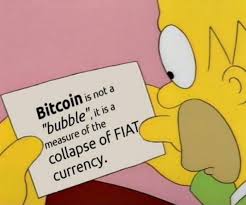
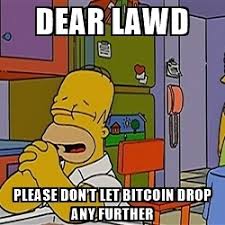 see where this all goes. Remember the Internet in the late 90’s when many apparently silly ideas with a “dot com” attached to their names would surely change our lives dramatically in the future, and these ideas were driving massive speculation in stock markets prices. And then it all burst in the economic crash of 2000. With hindsight, we can now see how that has played out after all the crushed dreams and silliness are gone.
see where this all goes. Remember the Internet in the late 90’s when many apparently silly ideas with a “dot com” attached to their names would surely change our lives dramatically in the future, and these ideas were driving massive speculation in stock markets prices. And then it all burst in the economic crash of 2000. With hindsight, we can now see how that has played out after all the crushed dreams and silliness are gone.
Yes, it was a bubble, but yes the technology did change the world dramatically once people figured out the true value in it.
There may be something to this Bitcoin thing.
Watching this Bitcoin story unfold in December certainly added a different angle to the Christmas cheer in our house: while kids were drooling over the latest toys that might make the Christmas list, Dad (at least) was drooling over the surge in Bitcoin value.
But then the hangover set in..
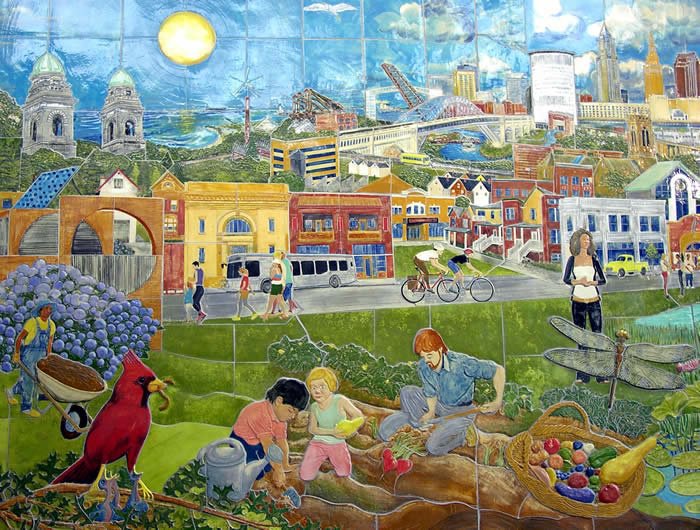
by wemakedo | Nov 10, 2017 | community |
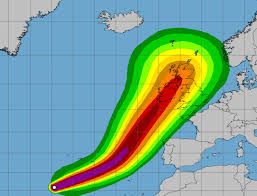 Our recent brush with the formidable Hurricane Ophelia and then a week later with the more colloquial sounding storm “Brian”, may have shaken our thinking that nothing very seriously bad ever happens in little ol’ Ireland.
Our recent brush with the formidable Hurricane Ophelia and then a week later with the more colloquial sounding storm “Brian”, may have shaken our thinking that nothing very seriously bad ever happens in little ol’ Ireland.
We are used to watching TV footage of storm-ravaged homes and people whose lives have been turned upside down in areas we typically associate with hurricanes, earthquakes and other natural disasters. But maybe now we can feel a little more empathy towards those situations and realise that natural disasters are perhaps something we should give a little more thought to in this part of the world.
Our WeMakeDo family philosophy has at times swung from the milder form of doing what we can to limit our harmful impact on the world to sometimes more extreme thoughts of how would we fare in the event of an extreme disaster where some degree of self-sufficiency may become very important.
The Normalcy Bias – sometimes also called the ostrich effect – is an effect that biases people’s thinking when faced with the prospect of disaster. We all tend to have this bias to varying degrees which dictates that things will continue to be normal because they have always been normal. This bias can come into play when we face a potential disaster situation and try to plan accordingly. The bias will tend to make us think things will never be as bad for us as we know it can be for others.
In true Irish fashion, before Ophelia struck, there were jokes going around about how Guinne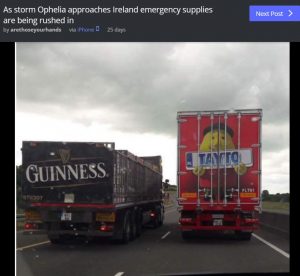 ss and Taytos were all that was needed to weather it out. Maybe we just are that relaxed about things but perhaps there was some Normalcy Bias at play. It can result in way over-optimistic interpretations of warnings as well as an inability to cope well when faced with real disaster situations when they do occur.
ss and Taytos were all that was needed to weather it out. Maybe we just are that relaxed about things but perhaps there was some Normalcy Bias at play. It can result in way over-optimistic interpretations of warnings as well as an inability to cope well when faced with real disaster situations when they do occur.
Ophelia has been a striking example of why we should acknowledge that this kind of event can happen here. We should not assume we won’t experience disaster just because we have never really experienced it in recent memory.
Watching the aftermath of the storm unfold was interesting. It would seem that other than some specific tragic incidents during the storm, the broader population was merely inconvenienced by this storm. Our family like so many others lost our power, but only for a day and our water supply for the same time (as we are on a well). Others around us lost their power for a week and daily life for those families was certainly tough for those few days. What was eye-opening is how truly helpless we can be when we lose centrally supplied power or centrally supplied water. The loss of internet access in our home for a day was difficult enough!
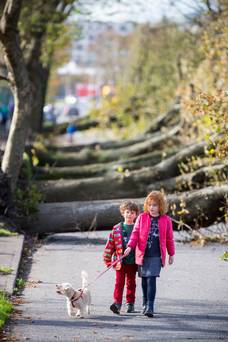 Power was slowly restored and roof tiles were replaced and life went on for those of us less impacted by the storm. But should we give a little more thought to how well set up our current way of life is for dealing with large-scale disaster?
Power was slowly restored and roof tiles were replaced and life went on for those of us less impacted by the storm. But should we give a little more thought to how well set up our current way of life is for dealing with large-scale disaster?
It’s not so much that we should expect to have to deal with large storms like this on a more regular basis although this may become a feature of our altering climate; its more that we have become very dependent on centralised supplies in our modern lives. Our normalcy bias has us believing that this way our highly inter-dependent society is now set up is not at risk at all. We generally don’t even give it a second thought.
Assuming normalcy means that we assume there will always be a supermarket to get our food, water will always come out of the tap, and our lights will always turn on when we flip the switch.
The purpose of this article is not to suggest that we should introduce paranoia into our daily lives but perhaps we should give some thought towards how we could manage in the event of minor emergencies or disaster situations and how we can improve either our self-reliance or our local reliance. We should not assume that the government or the free market will always be able to provide for us in crisis events and believing this may be quite naive.
Through pursuing economies of scale and profit, big business has slowly been changing how our communities acquire goods and services and also who is able to provide these goods and services. Food supply is obviously an important aspect of a resilient community. Most of us are aware of how large supermarket chains squeeze small food suppliers out of existence. Thankfully in Ireland, it seems there is no shortage of small food producers who by their existence, add a high degree of resilience to our communities.
Other concepts which can help build community resilience and strengthen connections:
- Food co-ops where people buy produce in bulk and distribute it amongst members of the community who join up.
- Local currency initiatives – such as the Kilkenny “CAT” which was proposed in 2010 but doesn’t seem to have happened or the thriving local versions in some UK cities like the Bristol Pound and Liverpool Pounds, which serve to encourage money circulation within local enterprises and communities.
- Lending libraries are a relatively new concept in Ireland and have started in Dublin: the same concept as book libraries only for other household items such as tools, garden equipment etc. The kind of things many of us only need occasionally and so can be better shared rather than owned with little use.
- Well attended farmers markets which incentivise local producers to meet local needs.
- LETS or Local Exchange Trading Systems which relies on credits and not currency to exchange skills and resources. This bartering system allows for people to trade skills and provides a useful outlet for people with skills to trade for other needs. Cork has such a system set up: Cork LETS Network
Another thought we had when we lost our power for a day was: for people who like to figure things out for themselves, how much of the wealth of online knowledge do we actually retain so that it might be of use to us if the electricity supply failed for a significant period of time. The WeMakeDo family love to try fixing things making use of the wealth of online guides and resources now available, but one wonders how much of that knowledge do we retain? With no power (and no internet) one wonders if one could figure out how to make, for example, a manual well pump to get a supply of water?
It’s not likely that our lives would ever depend on figuring this out, but it’s food for thought.

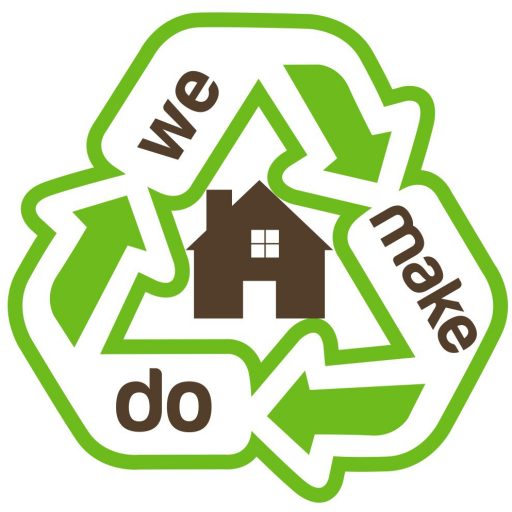



 A little background on the IPCC report: this report was commissioned in 2015 after the Paris Climate Accord when it was not really clear what would happen if the world were to limit the global temp increase to 1.5C above pre-industrial temperatures (before 1900) versus limiting it to 2C. This report was requested to go figure out the real world scenarios in both cases.
A little background on the IPCC report: this report was commissioned in 2015 after the Paris Climate Accord when it was not really clear what would happen if the world were to limit the global temp increase to 1.5C above pre-industrial temperatures (before 1900) versus limiting it to 2C. This report was requested to go figure out the real world scenarios in both cases.

 You may have heard the EV related phrase known as – “range anxiety” which newbies experience as they learn to manage their electric car’s needs. It’s real!
You may have heard the EV related phrase known as – “range anxiety” which newbies experience as they learn to manage their electric car’s needs. It’s real!
 We did at least try to use fabric to wrap the stuff under the tree which worked well, but there was no doubt that the whole event was too much about the purchases despite some vague earlier intentions to inject some other values into the occasion and try to give it a broader meaning. The whole idea of teaching kids to be good so that they can get more stuff from Santa on Christmas day seems like such an outdated lesson to giving our children. What natural conclusions would young minds draw from this as they see it played out year after year at Christmas time? It’s a very self-interested and greed-inducing message to give. Isn’t it time we moved on from this?
We did at least try to use fabric to wrap the stuff under the tree which worked well, but there was no doubt that the whole event was too much about the purchases despite some vague earlier intentions to inject some other values into the occasion and try to give it a broader meaning. The whole idea of teaching kids to be good so that they can get more stuff from Santa on Christmas day seems like such an outdated lesson to giving our children. What natural conclusions would young minds draw from this as they see it played out year after year at Christmas time? It’s a very self-interested and greed-inducing message to give. Isn’t it time we moved on from this?
 We also spent the month of December (and November, and October…) glued to the price of Bitcoin. It’s a digital currency or “cryptocoin” that has been in operation since 2010 and has recently become more widely known.
We also spent the month of December (and November, and October…) glued to the price of Bitcoin. It’s a digital currency or “cryptocoin” that has been in operation since 2010 and has recently become more widely known.
 see where this all goes. Remember the Internet in the late 90’s when many apparently silly ideas with a “dot com” attached to their names would surely change our lives dramatically in the future, and these ideas were driving massive speculation in stock markets prices. And then it all burst in the economic crash of 2000. With hindsight, we can now see how that has played out after all the crushed dreams and silliness are gone.
see where this all goes. Remember the Internet in the late 90’s when many apparently silly ideas with a “dot com” attached to their names would surely change our lives dramatically in the future, and these ideas were driving massive speculation in stock markets prices. And then it all burst in the economic crash of 2000. With hindsight, we can now see how that has played out after all the crushed dreams and silliness are gone.



